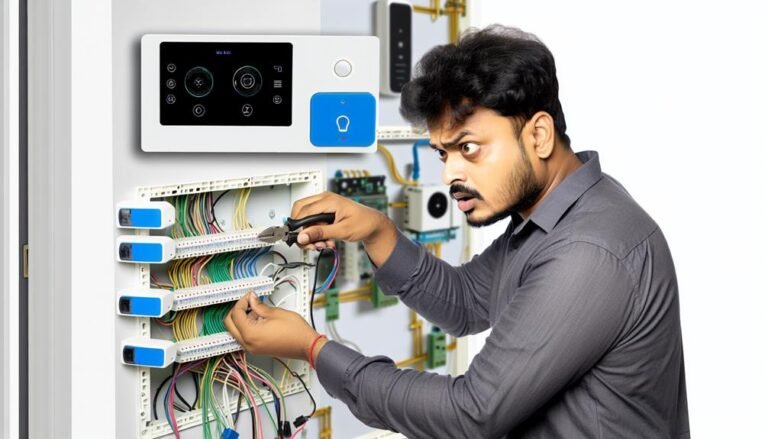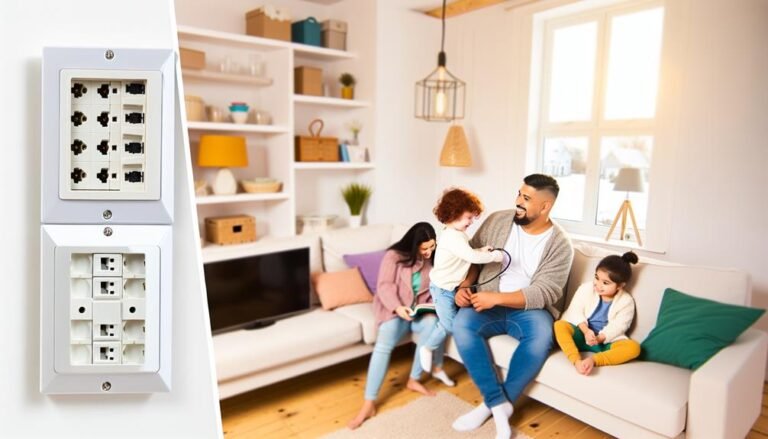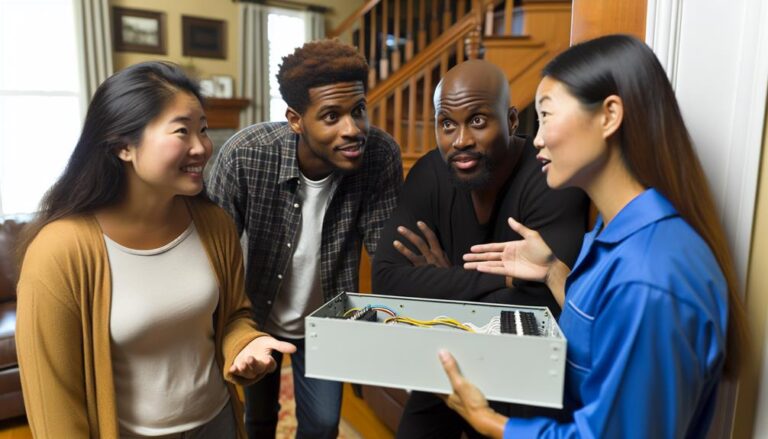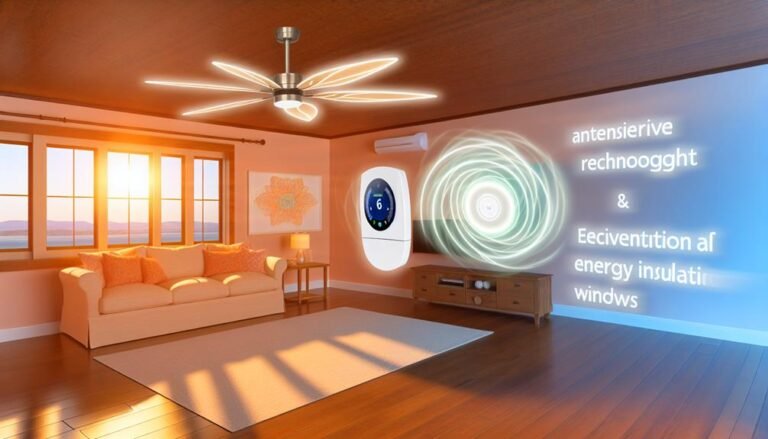The Role of a Residential Electrician in Modern Home Design
Like a skilled conductor leading an orchestra, a residential electrician plays a vital role in the symphony of modern home design. From designing smart home automation systems to integrating renewable energy sources, their expertise is crucial in creating homes that are not only aesthetically pleasing but also technologically advanced.
But their responsibilities go beyond just wiring and installation. They ensure electrical safety and compliance, enhance energy efficiency, and collaborate closely with architects and interior designers to bring innovative ideas to life.
In this ever-evolving landscape of modern home design, the role of a residential electrician is more important than ever. So, let’s explore the fascinating ways they shape our homes of tomorrow.
Key Takeaways
- A residential electrician plays a crucial role in designing smart home automation systems by assessing homeowner needs, considering desired features, determining compatibility, and ensuring security measures.
- Integrating renewable energy sources such as solar power and small wind turbines is essential for achieving maximum efficiency and reducing carbon footprint, and a residential electrician can help in this process.
- Ensuring electrical safety and compliance is a top priority for a residential electrician, including adhering to electrical code compliance, conducting safety inspections, and preventing electrical accidents.
- Enhancing energy efficiency in home design is another important aspect where a residential electrician can contribute by installing energy-efficient lighting, utilizing smart home automation systems, optimizing heating and cooling settings, and incorporating energy-efficient appliances.
Designing Smart Home Automation Systems
When designing smart home automation systems, it’s crucial to consider your specific needs and preferences as a homeowner. Smart home automation systems are designed to provide convenience, comfort, and security in your daily life. These systems integrate various devices and technologies to automate and control different aspects of your home, such as lighting, heating, cooling, security, and entertainment systems.
To begin designing a smart home automation system, you should assess your requirements and priorities. Consider what features and functionalities are important to you. Do you want to be able to control your home remotely through your smartphone or voice commands? Are energy efficiency and cost savings a priority for you? By understanding your needs, you can select the right devices and technologies that align with your goals.
Next, you need to determine the compatibility of your existing devices and systems with the smart home automation system. Some devices may require additional hardware or software integration to work seamlessly with the automation system. It’s important to ensure that all devices can communicate and interact with each other effectively.
Furthermore, you should consider the scalability and flexibility of the smart home automation system. As your needs and preferences evolve over time, you may want to add or upgrade devices. A scalable system allows for easy expansion and integration of new devices without significant disruptions or additional costs.
Lastly, security is a critical aspect of smart home automation systems. Ensure that the system has robust security measures in place to protect your personal data and prevent unauthorized access. This includes strong passwords, encryption, and regular software updates.
Integrating Renewable Energy Sources
To expand on the capabilities of your smart home automation system, consider integrating renewable energy sources to further enhance the sustainability and efficiency of your home.
Renewable energy sources, such as solar power and wind energy, offer numerous benefits that can greatly improve the functionality and cost-effectiveness of your home.
Solar power is perhaps the most popular and widely-used renewable energy source for residential homes. By installing solar panels on your roof, you can harness the power of the sun and convert it into electricity to power your home. This not only reduces your reliance on the grid but also helps you save on your energy bills. Additionally, excess solar energy can be stored in batteries for later use or even sold back to the grid, providing you with additional savings and potential income.
Wind energy is another viable option for integrating renewable energy into your home. Small wind turbines can be installed on your property to generate electricity from the wind. While wind energy may not be as consistent or reliable as solar power, it can still contribute to your overall energy needs, especially in areas with favorable wind conditions.
Integrating renewable energy sources into your smart home automation system allows you to have greater control and flexibility over your energy usage. By monitoring and optimizing the energy production and consumption in your home, you can achieve maximum efficiency and reduce your carbon footprint.
Ensuring Electrical Safety and Compliance
To ensure the electrical safety and compliance of your modern home design, it’s essential to employ the expertise of residential electricians. These professionals are trained to handle the intricate electrical systems that power our homes and ensure that they meet all safety standards and regulations.
Here are three key areas where residential electricians play a crucial role in ensuring electrical safety and compliance:
- Electrical Code Compliance: Residential electricians are well-versed in the National Electrical Code (NEC) and local building codes. They ensure that all electrical installations in your home meet these codes, which are designed to protect against electrical hazards and ensure safe operation.
- Grounding and Bonding: Proper grounding and bonding are critical for electrical safety. Residential electricians ensure that your home’s electrical system is properly grounded, which helps protect against electrical shock and provides a safe path for electrical currents. They also ensure that all electrical equipment and metal components are properly bonded, reducing the risk of electrical fires and electrocution.
- Safety Inspections: Residential electricians perform safety inspections to identify potential electrical hazards and ensure that all electrical components in your home are functioning properly. They check for overloaded circuits, faulty wiring, and outdated electrical panels, among other issues. By addressing these problems, residential electricians help prevent electrical accidents and ensure the overall safety of your home.
Enhancing Energy Efficiency in Home Design
Residential electricians are instrumental in maximizing energy efficiency in home design. By incorporating advanced electrical systems and technologies, they help homeowners reduce their energy consumption, lower utility bills, and minimize their environmental impact. One way electricians achieve this is by installing energy-efficient lighting solutions, such as LED bulbs, which consume less electricity and have a longer lifespan compared to traditional incandescent bulbs.
Another important aspect of energy-efficient home design is the use of smart home automation systems. These systems allow homeowners to control and monitor their energy usage remotely, enabling them to make informed decisions about when and how to use electricity. For example, with a smart thermostat, you can optimize your home’s heating and cooling settings based on your schedule, saving energy and money.
To illustrate the impact of energy-efficient home design, consider the following table:
| Energy-Saving Measure | Potential Savings |
|---|---|
| LED Lighting | Up to 80% |
| Smart Thermostat | Up to 20% |
| Energy-Efficient Appliances | Up to 30% |
Collaborating With Architects and Interior Designers
Collaborating with architects and interior designers is crucial for residential electricians in ensuring seamless integration of electrical systems into modern home designs. By working closely with these professionals, electricians can contribute their expertise to create functional and aesthetically pleasing spaces that meet the needs and desires of homeowners.
Here are three key aspects of collaboration between electricians, architects, and interior designers:
- Understanding the design concept: Electricians need to familiarize themselves with the overall design concept of the home to ensure that the electrical systems align with the desired aesthetic and functionality. This involves reviewing architectural plans, discussing lighting requirements, and considering the placement of outlets and switches to achieve an optimal layout.
- Planning for future needs: Electricians collaborate with architects and interior designers to anticipate future electrical needs. This involves considering potential technological advancements, such as smart home automation systems, electric vehicle charging stations, and renewable energy integration. By planning ahead, homeowners can avoid costly retrofits in the future.
- Coordinating installations: Collaboration allows electricians to work alongside architects and interior designers to coordinate the installation of electrical systems during the construction or renovation process. This ensures that wiring, lighting fixtures, and other electrical components are seamlessly integrated into the design, minimizing the need for visible conduits or modifications later on.
© 2025 By Electrician Phoenix







